Are you running out of at-home date night ideas? Whether you’re trying to save money by dining in or simply don’t feel like going out, a Japanese-themed dinner lets you have a dream date without even leaving the house. If you’re more interested in eating and conversing than playing chef for the night, there are many quick, easy Japanese meals you can whip up in no time.
To help you create a romantic date night at home, we’ll walk you through the basic components of a typical Japanese menu to impress and offer inspiration for delicious recipes. Discover the secrets to a successful Japanese dinner date night below.
Table of Contents
Components of a Traditional Japanese Dinner
Easy Japanese Dinner Recipes for Date Night
Use SAN-J Sauces to Make Your Japanese Dinner Date Night a Success
Components of a Traditional Japanese Dinner
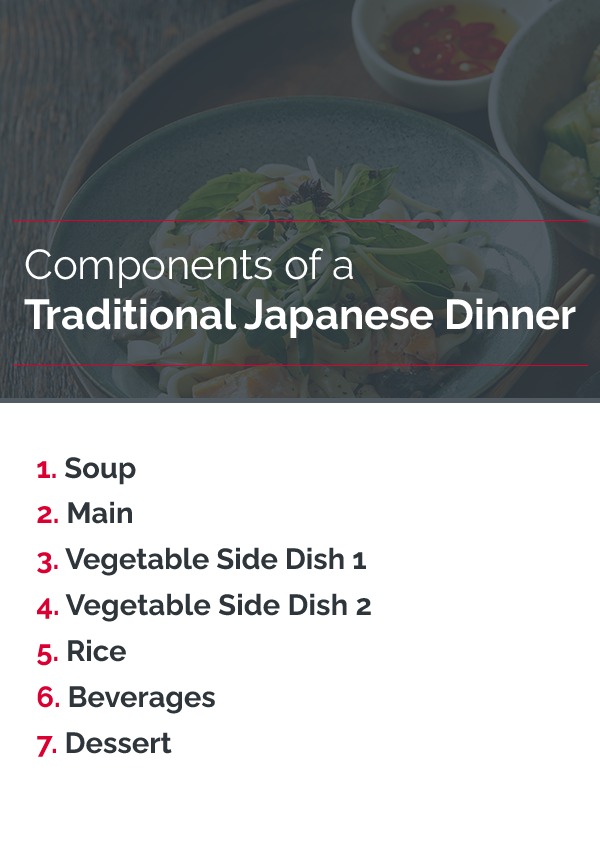
Before diving into cooking Japanese cuisine, understand the main elements of a typical Japanese meal. A typical home-style Japanese dinner consists of one soup and three dishes, along with a bowl of rice. This is called “Ichiju Sansai(一汁三菜), which literally means one soup three dishes. The soup, one main dish, and two other vegetable side dishes are set out at the same time during a Japanese dinner, as opposed to the multi-course meals typically found in Western and European cultures. Following the meal, there may be dessert which is usually seasonal, peeled, seeded, and nicely cut fresh fruits.
Create your Japanese-themed date night dinner by understanding the main components of a traditional meal:
Soup
A typical Japanese dinner includes a light soup. The most common type is miso soup, which has a miso base and can include a variety of ingredients. Miso soup is most often kept simple and involves only a few basic ingredients, such as tofu and green onions, because it’s not intended to fill you up.
Another popular soup is Japanese Noodle Soup that incorporates Udon noodles, Red Miso Paste and our Tamari Soy Sauce. Check out our recipe.
Main
Typical Japanese dinners usually involve seafood because the country is surrounded by the sea. Traditional recipes from this island country may include grilled fish, fried fish, raw fish known as sashimi or other seafood, such as shrimp. Japanese recipes can include other protein sources as well, like poultry, pork, beef and tofu.
Vegetable Side Dish 1
Along with seafood, vegetables are a staple of Japanese-style cooking. Typically, vegetables are simmered in a savory fish broth seasoned with soy sauce, mirin, and sake, the most common version of the Japanese seasoning combination. Or vegetables are sautéed, boiled or steamed in water. Some dishes include protein along with vegetables. Japanese vegetable side dishes are often kept simple.
Vegetable Side Dish 2
The other side dish is usually a lighter, vegetable dish, such as goma-ae, blanched vegetables tossed with soy sauce, sesame and sugar, or a Japanese-style salad which is vinegar marinated vegetables, such as cucumber salad. This salad portion of a Japanese meal could be a Western-style fresh lettuce salad.
Rice
Whether it be white or brown rice, every traditional Japanese dinner includes steamed rice. Sometimes, the steamed rice may be mixed with grains, beans and seeds, such as azuki beans, millet, quinoa, and sesame seeds. Japanese steamed rice is often served with nori — seasoned dried seaweed — or furikake — a dry rice seasoning condiment — and accompanied by pickled vegetables. There are rice dishes called Takikiomi Gohan, rice cooked with vegetables and seasonings for more flavorful options.
Beverages
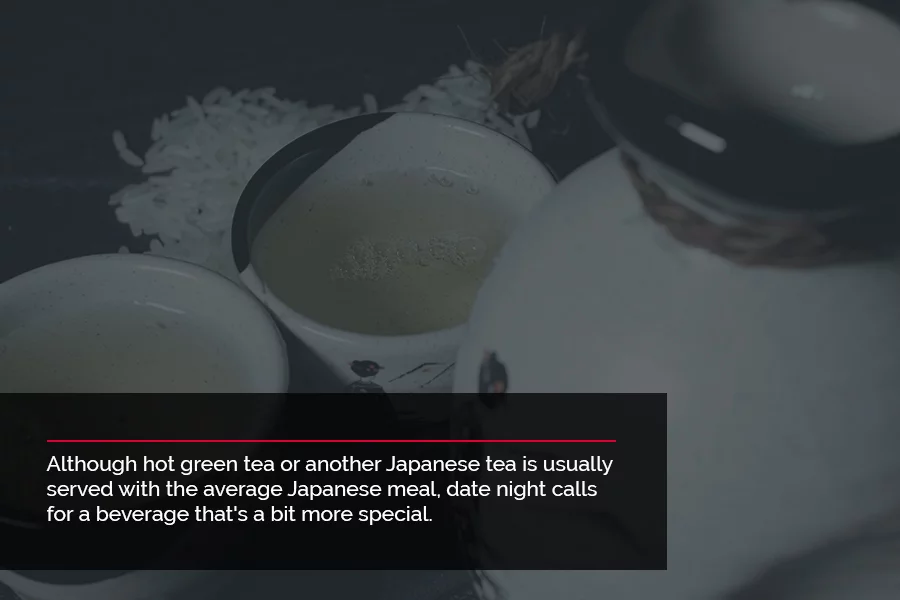
A traditional Japanese meal is not complete without a cup of hot green tea. Sometimes, a different Japanese tea is served alongside a meal, such as mugicha, a cold barley tea that’s popular during the hot summer months. On special occasions, alcoholic beverages like sake or beer may be paired with Japanese cuisine.
Dessert
Typically, peeled and nicely cut, fresh fruits are served after meal as a dessert. Other special desserts may be served for special occasions. Japanese desserts range from sweet rice cakes and pastries, Japanese-style cheesecake, to gelatins and frozen treats, such as mochi ice cream.
Easy Japanese Dinner Recipes for Date Night
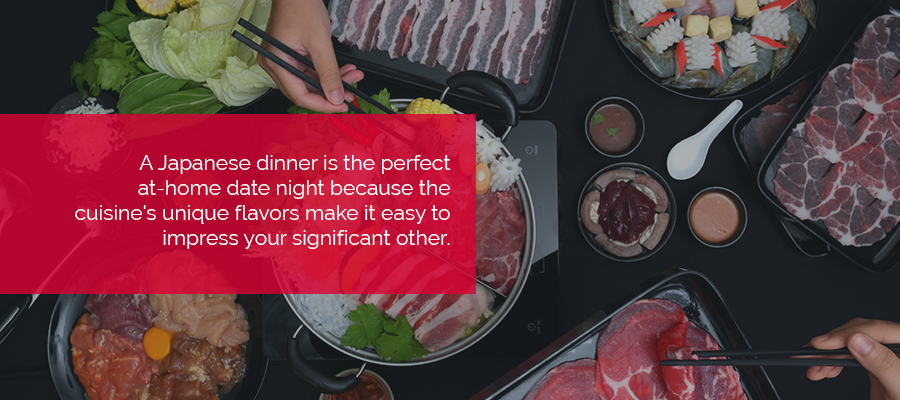
A Japanese dinner is the perfect at-home date night because the cuisine’s unique flavors make it easy to impress your significant other. Japanese cuisine stands out for its exceptional use of umami, which is a deeply satisfying, savory flavor that comes from foods like seafood, soy sauce and mushrooms. Because umami is one of the five basic tastes, Japanese dishes often appeal to our senses in a way other cuisines don’t.
Below are quick, easy Japanese recipes for each component of a traditional meal to help you capture those flavors.
Soups
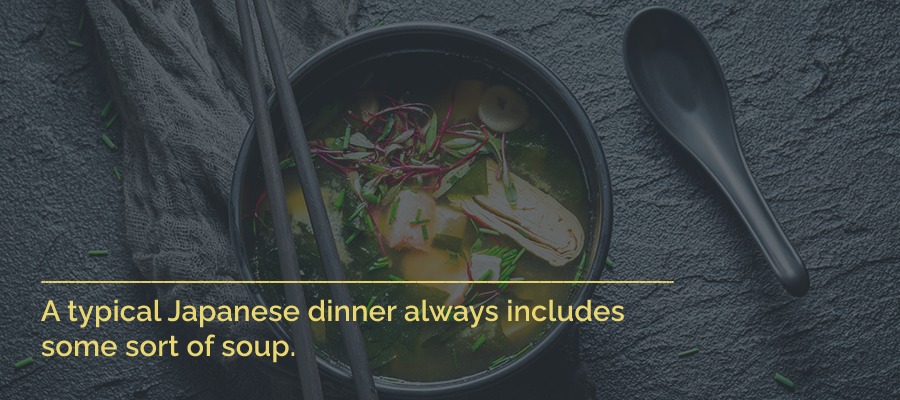
A typical Japanese dinner always includes some sort of soup. Japanese-style soups are almost always hot, as chilled soups are far less popular. Because all of the food is served at once during a Japanese meal, it is important to keep the soup light to save room for all the other tasty dishes.
If you’re looking for a warm way to kick off date night, here are a few easy Japanese soup recipes that are sure to be a hit:
- Miso soup: This classic Japanese soup is the perfect starter dish. With a light, savory broth and silky soft tofu, this miso soup recipe is just enough to whet your appetite. To really impress your date, use SAN-J Tamari Soy Sauce, which will give your miso soup a deeper flavor profile. Or use SAN-J White Miso Soup Mix so you can save a bit of time and focus more on making the main dishes.
- Noodle soup: Although a bit more filling than miso soup, this Japanese noodle soup recipe makes a lovely lead-up to any entrée. This noodle soup, full of fresh ingredients and savory red miso paste, is a snap to prepare and complements other umami-rich dishes well. Make sure you slightly undercook the noodles so they don’t get too soft in the broth.
- Rice soup: On cold winter days when you just want a cozy cup of soup, this teriyaki chicken and rice soup recipe makes the perfect accompaniment for a Japanese meal. With only a few main ingredients, this simple soup is warming but not filling. The addition of SAN-J Teriyaki Sauce boosts the broth’s flavor without making the soup overly rich.
- Wakame soup: Wakame is a type of edible seaweed quite popular in Japan. The distinct and subtly sweet taste makes it a sensational ingredient that will surely make your soup stand out. This green leek and SAN-J Wakame Soup recipe is full of thinly sliced vegetables to bring out the wakame’s taste and make every bowl taste like it came fresh from the garden. You can also use a SAN-J Wakame Soup Mix if you want to spend less time in the kitchen on date night.
Main Dishes
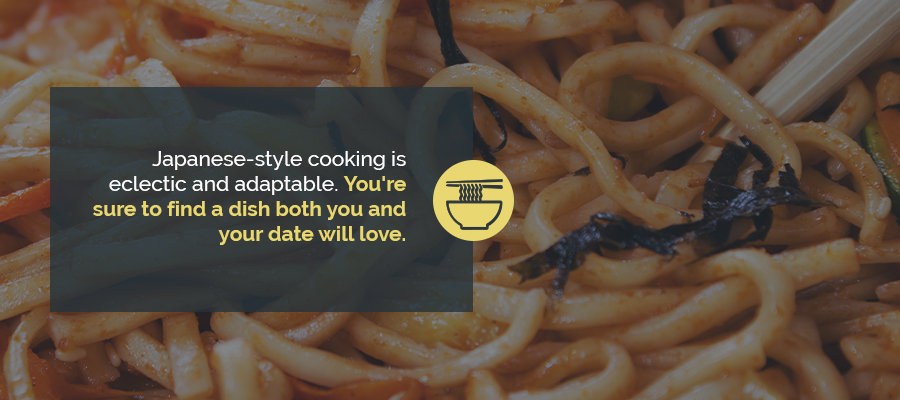
The star dish of your traditional Japanese dinner can vary depending on your tastes and dietary needs. While there are certainly some signature Japanese main dishes, Japanese-style cooking is eclectic and adaptable. You’re sure to find a dish both you and your date will love.
Here are the main categories of entrées along with some delicious Japanese dinner recipes to choose from:
- Pork: Japanese-style cooking offers plenty of succulent and savory options for pork fans. Combine grated ginger, sake, mirin, sugar and SAN-J Tamari Soy Sauce to create a flavorful sauce for Japanese Ginger Pork (Shoga-Yaki). This dish glazes pork with the slightly sweet, salty and umami flavors of a ginger sauce and serves perfectly with rice.
- Beef: What could be better for date night than a tender, juicy steak? If you want your date night to feel high-class without going out to an expensive steakhouse, try making your own Japanese-style steak at home. With this beef negimaki recipe, you can cook up a restaurant-quality traditional Japanese steak dish without breaking the bank. As a bonus, the savory and complex flavors of the SAN-J Teriyaki Sauce will be sure to impress your date.
- Chicken: If you’re trying to avoid red meat, there are plenty of poultry options in Japanese cuisine. One of the tastiest Japanese main dishes made with chicken is this ramen with teriyaki chicken recipe. Ramen is a Japanese staple for a reason — it’s easy to make, inexpensive and delicious. Elevate your bowl of noodles by topping it with teriyaki chicken, shiitake mushrooms, sautéed bok choy, bean sprouts and a soft-boiled egg. The rich flavor and mild sweetness of the SAN-J Teriyaki Sauce will take your ramen to new heights.
- Seafood: Japanese cooking includes various seafood dishes, so don’t worry if you don’t know how to roll your own sushi. You can easily wow your date by preparing these pan-seared ahi tuna steaks, which strike the perfect balance between delicate and rich. The delightfully crisp outside of the tuna steaks gives way to a lush center bursting with umami flavor.
- Rice: Japanese rice dishes are often combined with a protein like oyako donburi, a traditional chicken and egg with rice dish. This oyako donburi recipe receives a flavor boost from umami-rich SAN-J Tamari Soy Sauce and thinly sliced shiitake mushrooms. Ladle the full-flavored ingredients over Japanese rice to create the perfect bowl of comfort food.
- Noodles: When it comes to Japanese noodle dishes, none stand out quite as much as yaki udon. Yaki udon is a flavorful and easy variation of stir-fried noodles that involves thick, chewy wheat noodles. Top them with a savory soy sauce and mirin sauce along with your choice of protein and vegetables. You can make this simple yaki udon noodle recipe with frozen udon noodles and SAN-J Tamari Soy Sauce to give the dish a more complex taste.
- Vegetarian: Vegetarians will have no problem finding Japanese dishes that fit their diets — much of Japanese cuisine uses tofu or vegetables as the main ingredient. This simple Tamari tofu is easy to prepare and can be combined with a variety of main courses. Want a full vegetarian main dish? This Japanese buckwheat noodles with tempura vegetables recipe provides a delectable way to sneak some extra veggies onto your plate.
- Gluten-free: Many Japanese dishes are suitable for a gluten-free diet without having to make substitutions. The majority of grains and noodles used in Japanese cooking, such as rice and soba noodles, made with buckwheat only, are already gluten-free. Most Japanese cooking sauces like Tamari are available in gluten-free varieties, as well, letting you create flavorful dishes that suit your dietary needs.
Side Dishes
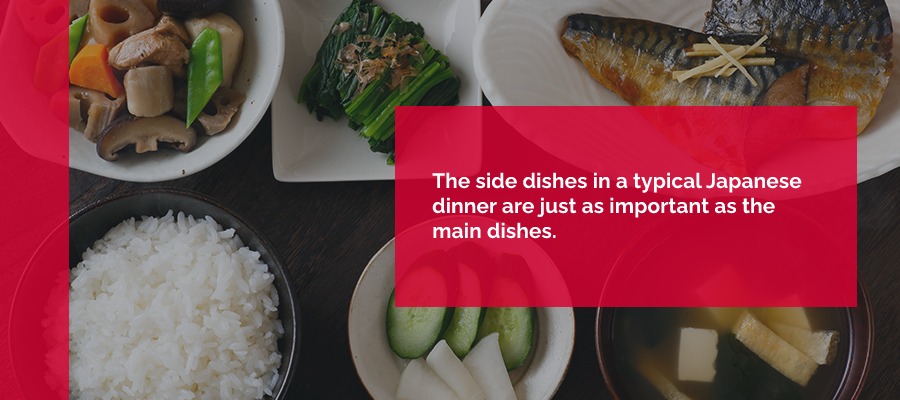
The side dishes in a traditional Japanese dinner are just as important as the entrées. Choose a couple of delicious side dish recipes for your date night to complement the flavors in your main dish. Luckily, there are plenty of mouth-watering Japanese side dish recipes that are quick and easy to prepare.
Here are a few sides you may want to consider to complete your Japanese meal:
- Kabocha with Tamari sake broth: Kabocha is a type of Japanese winter squash that tastes like a cross between a pumpkin and a sweet potato. This kabocha recipe simmers the squash in a simple Tamari sake broth to balance its sweetness with a bit of umami. Boiling the kabocha gives it a lovely fluffy texture that keeps the dish light, making it the perfect companion for any main dish.
- Ginger bok choy with shiitake mushrooms: Who said eating your greens had to be boring? This ginger bok choy with shiitake mushrooms recipe proves that veggies can be the best thing on the menu when prepared right. The complex flavors of shiitake mushrooms, sesame oil and SAN-J Tamari Soy Sauce coat the bok choy in tasty umami. And grated ginger and red pepper flakes give the dish a hint of spice. Toasted slivered almonds provide an extra layer of texture to give this recipe all the components of a great dish.
- Teriyaki noodles: Missed out on the terrific taste of teriyaki in your main dish? Not to worry — you can still get those rich flavors in your side. This recipe for teriyaki noodles uses the mild sweetness of SAN-J Teriyaki Sauce to make a simple and versatile side dish that pairs well with any entrée.
- Tofu and green bean stir fry: A quick stir fry is one of the easiest ways to whip up a stunning side dish in no time. This tofu and green bean stir fry recipe gives the veggies a makeover with the bold flavors of sweet chili garlic sauce. Tossing the green beans with pan-fried tofu gives this veggie-based side dish the richness it needs to hold its own on a fully stocked dinner table.
- Horenso Peanuts Aé: This quick and easy dish makes a fantastic addition to any Japanese meal and uses the classic SAN-J Thai Peanut Sauce. This side dish pairs with nearly any meal and is as nutritious as it is delicious.
- Avocado tofu salad: This bright and colorful avocado tofu salad is a great way to cleanse your palate before the main course. By using SAN-J Tamari Lite 50% Less Sodium, you can prevent the sauce’s salty taste from overpowering the wonderfully fresh avocadoes. A squeeze of lime juice finishes off this salad with a burst of citrus to balance the deeper umami flavors.
- Creamy wasabi dressing:This creamy wasabi salad dressing captures the bold flavor of wasabi while tempering the spice with a bit of mayonnaise to cut the heat. Thanks to a splash of SAN-J Tamari Soy Sauce, a bit of umami rounds out the dressing’s flavors.
- Shrimp and wakame salad: Wakame isn’t just for soup. The edible seaweed makes a delicious addition to this shrimp and wakame salad recipe. This light and refreshing salad is the perfect precursor for a traditional Japanese dinner.
- Miso yogurt dressing:This miso yogurt dressing recipe expertly balances the umami flavor of SAN-J Tamari Soy Sauce with a touch of sweetness. The creaminess of plain yogurt lightens the dressing up, making it perfect to pour over just about any type of salad or mixed vegetables.
Beverages
Although hot green tea or another Japanese tea is usually served with the average Japanese meal, date night calls for a beverage that’s a bit more special. Alcoholic beverages like sake and wine are often enjoyed with a Japanese dinner on noteworthy occasions. You can make your date night extra memorable by making an expert food and wine pairing.
Here is a quick guide to Japanese alcoholic beverages and their food pairings:
- Sake: Sake is an alcoholic beverage made from fermented rice that’s been polished to remove the bran. Because sake finds its origins in Japan, the drink pairs exceedingly well with traditional Japanese dishes like ramen, tempura and sushi.
- Koshu: Koshu is the most popular white wine grape from Japan. A koshu wine is light and crisp with fruity undertones. The delicate flavors of this wine typically pair best with leaner proteins like a white fish or tofu dish. Koshu wine is also a great match for spicier dishes, as their heat brings out the wine’s fruity flavors.
- Muscat Bailey A: Muscat Bailey A is Japan’s leading red wine grape. A pure Muscat Bailey A wine is super sweet, almost having the taste of bubble gum. But many Muscat Bailey A wines are blended with Western grapes to produce a drier, more full-bodied wine. This red wine variety is best enjoyed alongside a sweet and savory dish like teriyaki or a salty meat entrée, which balances out the wine’s sweetness.
- Sparkling wines: Sparkling wines are wildly popular in Japan for various reasons. Along with being delicious on any occasion, sparkling wines complement Japanese cuisine exceptionally well. The crisp, clean flavor of sparkling wines is the perfect partner for the delicate flavors of Japanese seafood dishes or a light stir fry. Sparkling wines are also a common pair with salty foods, perfect for meals with the salty, umami flavors of Tamari and other sauces.
Desserts
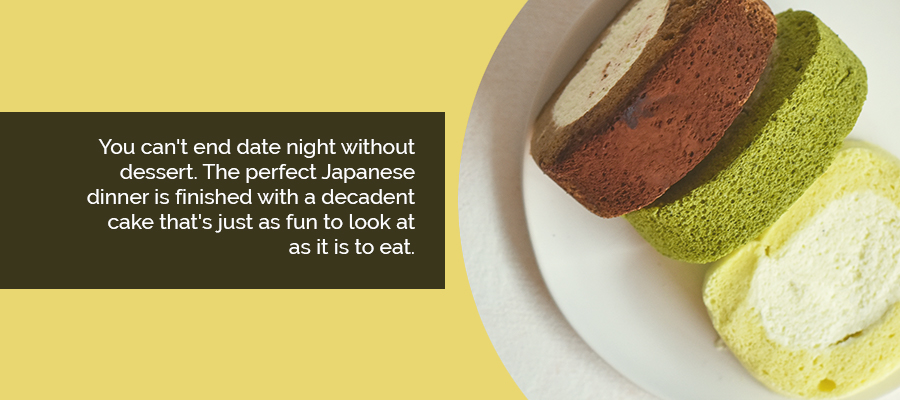
You can’t end date night without dessert. The perfect Japanese dinner is finished with a decadent cake that’s just as fun to look at as it is to eat. While you might not have all the cake decorating skills of a Japanese pastry chef, you can still make a delicious and aesthetically pleasing cake with the right recipe.
Here are a few Japanese dessert recipes to help end your date on a sweet note:
- Matcha chocolate swiss roll cake:This swiss roll cake is a work of art that combines traditional Japanese matcha with a rich chocolate drizzle. Matcha is a green tea powder widely used in Japanese cuisine to flavor anything from soup broth or noodles to lattes or ice cream. In this cake, the earthy flavors of matcha match well with the sweet taste of chocolate and the brightness of fresh raspberries.
- Chocolate pumpkin Bundt cake: If you’re already serving a side of kabocha, keep the squash theme going with this chocolate pumpkin Bundt cake. Whether it’s fall or not, this Bundt cake will be sure to warm both you and your date’s heart with its comforting flavors of cinnamon and cocoa powder.
- Cherry chocolate cake: Looking for something sweet, gooey and gluten-free? This cherry chocolate cake’s velvety texture will melt in your mouth while flooding your taste buds with chocolatey goodness. The secret ingredient of SAN-J Tamari Soy Sauce gives the cake a deeper flavor and makes it the Japanese version of Black Forest cake.
Use SAN-J Sauces to Make Your Japanese Dinner Date Night a Success
If you’re ready to try making a traditional Japanese dinner this date night, incorporate sauces from SAN-J. SAN-J Tamari Soy Sauce, Tamari Splash, and SAN-J Asian Cooking Sauces use simple ingredients to deliver an authentic flavor experience. Our sauces are also certified gluten-free, so they can give your dishes bold flavor while meeting your dietary needs.
Check out the wide variety of SAN-J Sauces today to get ready for your Japanese dinner date night.
Back to Top

